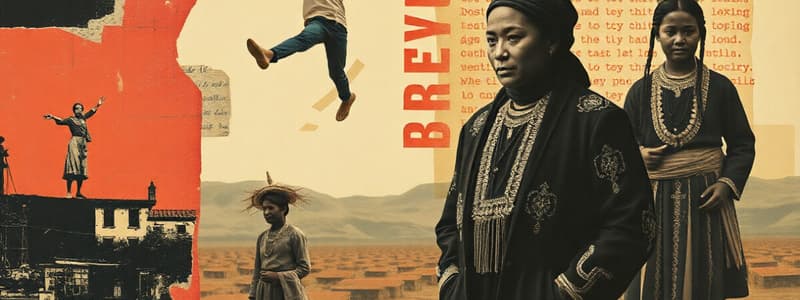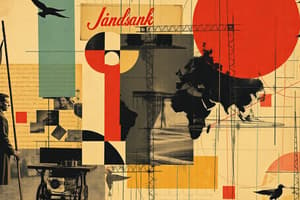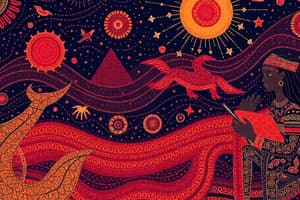Podcast
Questions and Answers
How have mission-oriented academic scholars and ethnographers often described indigenous communities?
How have mission-oriented academic scholars and ethnographers often described indigenous communities?
- Using outsider terms and categories of dominant societies. (correct)
- With detailed accounts of individual creativity and innovation.
- With precise accuracy and unbiased perspectives.
- Through the lens of developed intellectual ideas and high religiosity.
Which of the following is NOT a stereotype often associated with indigenous people?
Which of the following is NOT a stereotype often associated with indigenous people?
- Primal ancestor
- Technologically advanced innovator (correct)
- Childlike victim
- Pagan savage
What has been identified as a major obstacle to understanding indigenous lifeways?
What has been identified as a major obstacle to understanding indigenous lifeways?
- The lack of collaboration between indigenous communities and researchers.
- The unwillingness of indigenous peoples to share their traditions.
- The lack of written records and oral histories of indigenous peoples.
- The limited perspectives and interpretations from dominant societies. (correct)
What is crucial for fostering genuine dialogue with indigenous communities, according to the text?
What is crucial for fostering genuine dialogue with indigenous communities, according to the text?
What has been a key factor in reversing negative stereotypes about indigenous peoples in dominant societies?
What has been a key factor in reversing negative stereotypes about indigenous peoples in dominant societies?
According to the provided text, what is the leading resource in understanding indigenous ways?
According to the provided text, what is the leading resource in understanding indigenous ways?
Where are indigenous elders increasingly presenting their perspectives?
Where are indigenous elders increasingly presenting their perspectives?
What is occurring with indigenous oral narratives?
What is occurring with indigenous oral narratives?
What is the primary way indigenous people in towns and cities reaffirm their community membership according to the text?
What is the primary way indigenous people in towns and cities reaffirm their community membership according to the text?
How do indigenous lifeways generally extend the concept of 'person'?
How do indigenous lifeways generally extend the concept of 'person'?
According to J. Baird Callicott, how is human economic interaction with other species represented in Anishinabe/Ojibway traditions?
According to J. Baird Callicott, how is human economic interaction with other species represented in Anishinabe/Ojibway traditions?
What is the traditional understanding of what happens to slain animals in Anishinabe traditions?
What is the traditional understanding of what happens to slain animals in Anishinabe traditions?
Where do the reciprocal exchanges of the Anishinabe peoples with the natural world originate?
Where do the reciprocal exchanges of the Anishinabe peoples with the natural world originate?
What enhances the accessibility of mystical experiences?
What enhances the accessibility of mystical experiences?
What is Brown's critique of those who view indigenous thought as sentimental nature mysticism?
What is Brown's critique of those who view indigenous thought as sentimental nature mysticism?
What are the primary forms of transmission of these reciprocal lifeways, according to the text?
What are the primary forms of transmission of these reciprocal lifeways, according to the text?
What does increased pressure on indigenous homelands cause?
What does increased pressure on indigenous homelands cause?
What does Brown emphasize as crucial for spiritual experience in indigenous cultures?
What does Brown emphasize as crucial for spiritual experience in indigenous cultures?
What is the primary emphasis of the essay concerning the realms in indigenous religions and ecology?
What is the primary emphasis of the essay concerning the realms in indigenous religions and ecology?
What is a shared charateristic amongst Indigenous people regarding their relationship with nature?
What is a shared charateristic amongst Indigenous people regarding their relationship with nature?
Why are the four interacting spheres, personal, communal, natural and cosmological, significant in understanding indigenous religious knowledge?
Why are the four interacting spheres, personal, communal, natural and cosmological, significant in understanding indigenous religious knowledge?
How does the essay describe the relationship between the mysterious unknown and the observed world in indigenous religions?
How does the essay describe the relationship between the mysterious unknown and the observed world in indigenous religions?
According to the essay, how is the 'divine power' perceived in indigenous religions?
According to the essay, how is the 'divine power' perceived in indigenous religions?
What is essential to understanding indigenous knowledge according to the text?
What is essential to understanding indigenous knowledge according to the text?
What is the primary focus of the American Indian Quarterly 28.3-4 special issue?
What is the primary focus of the American Indian Quarterly 28.3-4 special issue?
Which concept does Gerald Vizenor’s work, 'Manifest Manners: Postindian Warriors of Survivance', explore?
Which concept does Gerald Vizenor’s work, 'Manifest Manners: Postindian Warriors of Survivance', explore?
What is a key topic discussed by David Suzuki and Peter Knudtson in 'Wisdom of the Elders: Sacred Native Stories of Nature'?
What is a key topic discussed by David Suzuki and Peter Knudtson in 'Wisdom of the Elders: Sacred Native Stories of Nature'?
What was a primary focus of the ethnographic work of Marcel Griaule among the Dogon people?
What was a primary focus of the ethnographic work of Marcel Griaule among the Dogon people?
What does the critique of Marcel Griaule's work by Walter E.A. van Beek primarily concern?
What does the critique of Marcel Griaule's work by Walter E.A. van Beek primarily concern?
What topic is primarily addressed by Vandana Shiva in 'Water Wars: Privatization, Pollution, and Profit'?
What topic is primarily addressed by Vandana Shiva in 'Water Wars: Privatization, Pollution, and Profit'?
What best describes the primary issue discussed by the publication 'Country of the Heart: An Indigenous Australian Homeland'?
What best describes the primary issue discussed by the publication 'Country of the Heart: An Indigenous Australian Homeland'?
What aspect of indigenous knowledge is highlighted within the content?
What aspect of indigenous knowledge is highlighted within the content?
What does the term 'fourfold interpretive context' primarily focus on?
What does the term 'fourfold interpretive context' primarily focus on?
In what way do indigenous lifeways challenge traditional interpretations of religion?
In what way do indigenous lifeways challenge traditional interpretations of religion?
What aspect of indigenous religions does the concept of 'lifeway' emphasize?
What aspect of indigenous religions does the concept of 'lifeway' emphasize?
What is a method used by indigenous elders to describe sacred experiences?
What is a method used by indigenous elders to describe sacred experiences?
How does the metaphor of 'text' apply to indigenous religions?
How does the metaphor of 'text' apply to indigenous religions?
Which of the following best describes the relationship between indigenous religions and their local environments?
Which of the following best describes the relationship between indigenous religions and their local environments?
What role do cosmological beings play in the context of indigenous lifeways?
What role do cosmological beings play in the context of indigenous lifeways?
What is a common misconception about the study of indigenous religions?
What is a common misconception about the study of indigenous religions?
How do indigenous peoples perceive their creation stories?
How do indigenous peoples perceive their creation stories?
What aspect of life do the values found in creation stories reflect?
What aspect of life do the values found in creation stories reflect?
In what way do indigenous peoples engage with the natural world?
In what way do indigenous peoples engage with the natural world?
What does the term 'embodiment' refer to in the context of indigenous religions?
What does the term 'embodiment' refer to in the context of indigenous religions?
What is a primary focus when exploring indigenous religions, according to the passage?
What is a primary focus when exploring indigenous religions, according to the passage?
What role do creation stories play in the traditions of indigenous peoples?
What role do creation stories play in the traditions of indigenous peoples?
What is NOT a characteristic of indigenous knowledge as described in the passage?
What is NOT a characteristic of indigenous knowledge as described in the passage?
What is the significance of narrations during rituals in indigenous cultures?
What is the significance of narrations during rituals in indigenous cultures?
Flashcards
Creation Stories as Lived Experiences
Creation Stories as Lived Experiences
Indigenous peoples' creation stories are more than just narratives; they are lived experiences that connect individuals to their environment and inform their spiritual and ecological practices.
Indigenous Knowledge and Local Environments
Indigenous Knowledge and Local Environments
Indigenous knowledge, embedded in local environments, plays a vital role in the lives of individuals and communities.
Indigenous Religions as Embodied Life
Indigenous Religions as Embodied Life
Indigenous religions are not separate from life but rather integrated dimensions of a unified body, encompassing personal, social, ecological, and cosmological realms.
Religious Practices and Ecology in Indigenous Cultures
Religious Practices and Ecology in Indigenous Cultures
Signup and view all the flashcards
Exploring Indigenous Religions
Exploring Indigenous Religions
Signup and view all the flashcards
Enduring Importance of Creation Stories
Enduring Importance of Creation Stories
Signup and view all the flashcards
Indigenous Perspective on the Natural World
Indigenous Perspective on the Natural World
Signup and view all the flashcards
Indigenous Traditions of the Americas
Indigenous Traditions of the Americas
Signup and view all the flashcards
Fourfold Embodiments
Fourfold Embodiments
Signup and view all the flashcards
Lifeways
Lifeways
Signup and view all the flashcards
Intertextuality of Native Religions
Intertextuality of Native Religions
Signup and view all the flashcards
Place-as-Text
Place-as-Text
Signup and view all the flashcards
Mix of Sense Knowledge and Conceptual Thought
Mix of Sense Knowledge and Conceptual Thought
Signup and view all the flashcards
Unmediated Experiences
Unmediated Experiences
Signup and view all the flashcards
Indigenous Religions and Ecology
Indigenous Religions and Ecology
Signup and view all the flashcards
Interpretive Effort
Interpretive Effort
Signup and view all the flashcards
Stereotype of Indigenous Cultures as Tradition-Bound
Stereotype of Indigenous Cultures as Tradition-Bound
Signup and view all the flashcards
Using Outsider Terms to Describe Indigenous Cultures
Using Outsider Terms to Describe Indigenous Cultures
Signup and view all the flashcards
Stereotype of Indigenous Cultures as Lacking in Individuality
Stereotype of Indigenous Cultures as Lacking in Individuality
Signup and view all the flashcards
Cultivating Understanding of Indigenous Wisdom Traditions
Cultivating Understanding of Indigenous Wisdom Traditions
Signup and view all the flashcards
Indigenous Elders as Voice in Global Discourse
Indigenous Elders as Voice in Global Discourse
Signup and view all the flashcards
Understanding Indigenous Ways of Knowing
Understanding Indigenous Ways of Knowing
Signup and view all the flashcards
Shifting from Outsider Interpretations to Indigenous Voices
Shifting from Outsider Interpretations to Indigenous Voices
Signup and view all the flashcards
Empathetic Ethnographies as Tools for Cultural Understanding
Empathetic Ethnographies as Tools for Cultural Understanding
Signup and view all the flashcards
Reaffirming Indigenous Membership
Reaffirming Indigenous Membership
Signup and view all the flashcards
Reciprocal Flow of Community Life
Reciprocal Flow of Community Life
Signup and view all the flashcards
Extending Personhood to the Natural World
Extending Personhood to the Natural World
Signup and view all the flashcards
Reciprocal Gift-Giving with Nature
Reciprocal Gift-Giving with Nature
Signup and view all the flashcards
Indigenous View on Species
Indigenous View on Species
Signup and view all the flashcards
Reincarnation of Slain Animals
Reincarnation of Slain Animals
Signup and view all the flashcards
Indigenous Lifeways as Integral
Indigenous Lifeways as Integral
Signup and view all the flashcards
Indigenous Activism Against Environmental Threats
Indigenous Activism Against Environmental Threats
Signup and view all the flashcards
Indigenous religions: Lived reality
Indigenous religions: Lived reality
Signup and view all the flashcards
The divine: Not just transcendent or immanent
The divine: Not just transcendent or immanent
Signup and view all the flashcards
Preparing for spiritual experiences
Preparing for spiritual experiences
Signup and view all the flashcards
Indigenous knowledge: Intertwined with daily life
Indigenous knowledge: Intertwined with daily life
Signup and view all the flashcards
Harmony between humans and environment
Harmony between humans and environment
Signup and view all the flashcards
Ceremonies as pathways to the divine
Ceremonies as pathways to the divine
Signup and view all the flashcards
Indigenous knowledge: Beyond facts
Indigenous knowledge: Beyond facts
Signup and view all the flashcards
Lessons from indigenous religions
Lessons from indigenous religions
Signup and view all the flashcards
What is indigenous knowledge?
What is indigenous knowledge?
Signup and view all the flashcards
What is decolonized future?
What is decolonized future?
Signup and view all the flashcards
What did the "American Indian Quarterly" focus on?
What did the "American Indian Quarterly" focus on?
Signup and view all the flashcards
What does the "decolonized future" aim to achieve?
What does the "decolonized future" aim to achieve?
Signup and view all the flashcards
What are creation stories?
What are creation stories?
Signup and view all the flashcards
What is the connection between indigenous religions and ecology?
What is the connection between indigenous religions and ecology?
Signup and view all the flashcards
What is "survivance"?
What is "survivance"?
Signup and view all the flashcards
What is the significance of studying indigenous religions?
What is the significance of studying indigenous religions?
Signup and view all the flashcards
Study Notes
Indigenous Traditions: Religion and Ecology
- Indigenous terms for "religion" and "ecology" may not directly translate to English equivalents
- "Ecology" is used to represent indigenous knowledge of traditional ecological and environmental knowledge
- Indigenous creation stories provide cosmological contexts for understanding self, society, and the world
- Creation stories are central to indigenous symbols and rituals, expressing spiritual and ecological intimacy
- Indigenous traditions in the Americas are examined, along with the concept of "embodied self"
- The fourfold embodiment: the individual, the native society, the community of life, and powerful cosmological beings
- Indigenous traditions are dynamic, adapting to change, sourced from observation of nature and visionary experiences, and recognized by the wider community
- Creation stories show connection to the natural world, not just as narratives, but as lived and embodied relationships with the environment
- Indigenous religions explore interactions with the natural world and the cosmos
- Indigenous knowledge often is transmitted through generations, not just as static data, but as dynamic and adapting living knowledge
- Indigenous knowledge is linked directly to the natural world
Lifeways in Indigenous Traditions
- "Lifeway" emphasizes the interaction of worldview and economy in small-scale societies
- Indigenous lifeways are often situated within dominant societies
- Indigenous lifeways are marked by close interactions with their homelands/environment, even in urban settings
- Indigenous communities maintain traditional relations with homelands while engaging in global marketplaces (e.g., water wars in Bolivia)
- Indigenous lifeways involve diverse interactions in urban and rural settings, and include practices dealing with trade, resource management and ceremonial life
- Indigenous lifeways are integral and embodied rather than separate from global economic forces
- Indigenous groups face encroachment on their lands by multinational corporations and dominant societies
- Indigenous religions are seen as significant ways to engage in personal, social, ecological, and cosmological realms
- Indigenous traditions emphasize relations with local environments, seen as essential for personal and societal growth
Lifeways and Embodiments
- Indigenous lifeways demonstrate close relationships between the individual, community, nature (ecology), and cosmological beings
- These relationships show context for understanding indigenous religions
- Indigenous knowledge viewed as interactive awareness rather than fixed, static text
- Indigenous lifeways link rituals, experiences and concepts like chants, sites, and interactions which are part of a wider whole
- A fourfold interpretive context should be used rather than just reduced to single explanations for indigenous religions
Issues in Understanding
- Indigenous perspectives on the natural world often involve rich and unmediated experiences of sacred encounters
- Indigenous elders often describe experiences involving the world, and relationships with others in the natural world.
- Cultural groups in North America including the Anishinabe, have perspectives that interweave person, society, the environment, and spiritual forces
- Concepts like “Grandma Earth” and spiritual forces are integral to their worldview
- Indigenous knowledge may not be understood by traditional Western categories of religion or science
Cosmological Body
- Indigenous cosmologies feature diverse beings
- Indigenous religions are not simply about separation or reductionism
- Indigenous cosmologies are significant, yet often misunderstood in mainstream thought
- Indigenous religious traditions frequently feature a multitude of spiritual figures and forces that are not separated from ordinary life lived in connection with the natural world
- Indigenous practices often involve intricate connections between the cosmological, the social, and the individual realm
- Indigenous knowledge is viewed in a dynamic, holistic framework and doesn't separate the spiritual and the everyday
Conclusion
- Indigenous traditions reveal diverse and interconnected insights into spiritual experiences
- Religious experiences encompass the interactions with the environment and spiritual realms
- Indigenous practices, knowledge and beliefs are not separate; they are integrated aspects of life and interconnected in many ways
- Indigenous knowledge often involves holistic perspectives that are inseparable from the everyday and from the spiritual or cosmological realms.
Studying That Suits You
Use AI to generate personalized quizzes and flashcards to suit your learning preferences.
Related Documents
Description
Test your understanding of indigenous communities through this quiz that covers common stereotypes, obstacles to understanding, and key factors in fostering dialogue. Explore the insights of scholars and ethnographers on the representation of indigenous peoples and their lifeways, as well as the importance of oral narratives and community membership.




